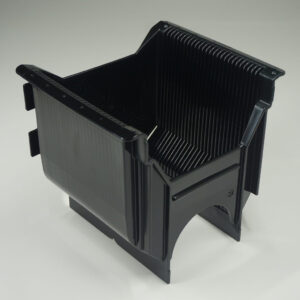Introduction to the anti static effect of plastics
The anti static effect of plastics depends on many factors, including the type of plastic, the antistatic agent added, environmental conditions, etc.
Common antistatic plastics achieve antistatic function by adding conductive fillers (such as carbon black, metal powder, etc.) or antistatic agents. The antistatic effect is usually measured by surface resistance, and it is generally believed that surface resistance in the range of 10^6 to 10^11 ohms has good anti-static performance.
Good antistatic plastics can effectively dissipate static electricity, and reduce static electricity accumulation and discharge, thereby reducing the risk of product damage, dust adsorption, electronic component failure, and other problems caused by static electricity.
However, it should be noted that the effect of antistatic plastics may change with changes in environmental factors such as time, temperature, and humidity. For example, in an environment with low humidity, the antistatic effect may be weakened. In addition, different types of antistatic plastics may also differ in the durability and stability of antistatic performance.
In short, the antistatic effect of plastics is a complex issue that requires comprehensive consideration of multiple factors and the selection of appropriate antistatic plastic materials based on specific application requirements.

Factors affect the anti static effect of plastics
- Processing technology: The temperature, pressure, shear force, and other conditions during the plastic molding process may affect the uniformity of the antistatic agent in the plastic, thereby affecting the antistatic performance. Too high a temperature may cause the antistatic agent to decompose or volatilize. Too high a pressure may cause the antistatic agent to be unevenly distributed in the plastic, resulting in local concentrations that are too high or too low. Too low a pressure may cause the internal structure of the plastic to be not dense enough, affecting the conduction and dissipation of the charge. Too fast an extrusion or injection speed may cause uneven filling of the plastic in the mold, affecting the uniform distribution of the antistatic agent. Too slow a speed may lead to low production efficiency, and the performance of the antistatic agent may be damaged due to prolonged heating. Reasonable processing parameters and good process control are essential to ensure the anti static effect of plastics.
- Type and amount of antistatic agent: Different types of antistatic agents (such as ionic, non-ionic, etc.) and their added ratios will directly affect the antistatic performance of plastics. Insufficient addition may lead to poor antistatic effect, while excessive addition may affect other properties of plastics.
- Plastic material: Different types of plastic substrates have different electrical properties, which affect the antistatic effect. For example, the molecular structure and polarity of some polymer materials may make it more difficult to achieve a good anti static effect.
- Environmental humidity: In a low-humidity environment, the moisture on the plastic surface decreases and the conductivity decreases, thus affecting the antistatic effect; while in a high-humidity environment, moisture helps the conduction of charge, and the anti static effect is relatively good.
- Temperature: Temperature changes may affect the physical properties of plastics and the activity of antistatic agents, thereby changing the anti static effect.
- Use time: As the use time increases, the antistatic agent may migrate, evaporate or lose, resulting in a gradual decrease in the anti static effect.
- Surface contamination: Dirt, grease, or other contaminants on the plastic surface may hinder the conduction of charges and reduce the effect.
- Friction and wear: Frequent friction and wear may damage the antistatic layer or structure on the plastic surface and weaken the antistatic ability.
- Electric field strength: The electric field strength in the environment will also affect the anti static effect of the plastic.




